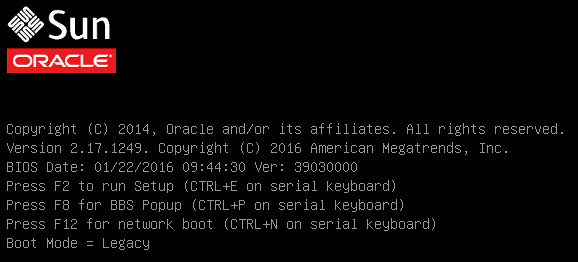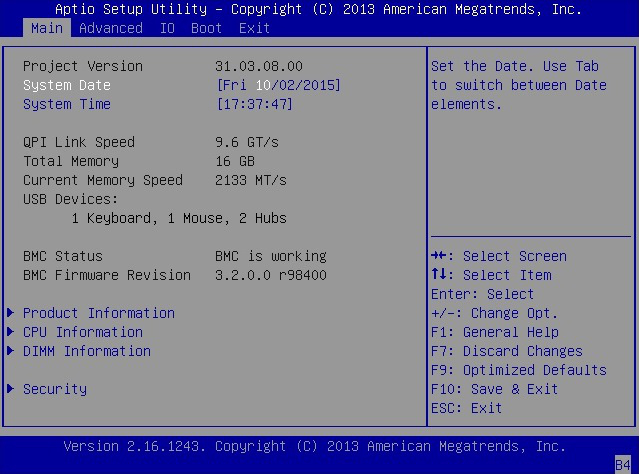Verify the UEFI Optimal Defaults
Note - If the server is newly installed and this is the first time that an operating system has been installed, then UEFI is probably configured to its default settings and you do not have to perform this task.
In the BIOS Setup Utility, you can set optimal defaults, as well as view and edit UEFI settings, as needed. By setting optimal defaults, you ensure that the server is operating efficiently with a configuration that is known to be good. You can review the optimal defaults in the Oracle Server X6-2L Service Manual.
Any changes you make in the BIOS Setup Utility using the F2 key are permanent until the next time you change them.
In addition to using the F2 key to view or edit the system's BIOS settings, you can use the F8 key during the boot process to specify a temporary boot device. If you use F8 to set a temporary boot device, this change is only in effect for the current system boot. The permanent boot device specified through F2 will be in effect after booting from the temporary boot device.
Before you begin, ensure that the following requirements are met:
-
The server is equipped with a hard disk drive (HDD) or solid state drive (SSD).
-
The HDD or SSD is properly installed in the server. For instructions, refer to Servicing Storage Drives and Rear Drives (CRU) in Oracle Server X6-2L Service Manual.
-
A console session is established to the server. For details, see Selecting the Console Display.
The following server BIOS settings may be required to use Oracle VM Server:
-
AHCI mode may be necessary to recognize the CDROM device to perform an installation from CDROM.
-
Disable I/O MMU Virtualization Settings; for Intel-based servers this is VT-d. I/O MMU (I/O Memory Management Unit) is not supported in this release.
-
Power on or reset the server.
For example, to reset the server, do one of the following:
-
From the local server, press the Power button on the front panel of the server (for approximately 1 second) to power off the server, and then press the Power button again to power on the server.
-
From the Oracle ILOM web interface, select Host Management → Power Control, select Reset from the Select Action list box, then click Save.
-
From the Oracle ILOM CLI, type: reset /System
The server begins the boot process, and the BIOS screen appears.

Note - The next events occur very quickly; therefore, be ready to press the F2 key. Watch carefully for messages as they appear on the screen for a brief time. You might want to enlarge the size of your screen to eliminate scroll bars. -
-
When prompted in the BIOS screen, press the F2 key to access the BIOS Setup Utility.
[Setup Selected] and the Boot Mode (Legacy or UEFI) are displayed at the bottom of the BIOS screen, then the BIOS Setup Utility appears.
Note - The BIOS Setup Utility screen might take a few minutes to appear.
-
Press the F9 key to automatically load the optimal default
settings.
A message appears prompting you to continue this operation by selecting OK, or to cancel this operation by selecting Cancel.
- In the message, highlight OK, and then press Enter.
-
To save your changes and exit the BIOS Setup Utility, press the F10 key.
Alternatively, you can select Save Changes and Exit from the Exit menu.